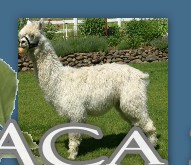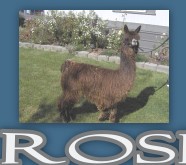|
Alpaca Info Library
What
is an Alpaca?
The
Alpaca (Vicugna pacos) is a
domesticated species of South American camelid
developed from the wild alpacas. It resembles a sheep in
appearance, but is larger and has a long erect neck as
well as coming in many colors, whereas sheep are
generally bred to be white.
Alpacas
are kept in herds that graze on the level heights of the
Andes of Ecuador, southern Peru, northern Bolivia, and
northern Chile at an altitude of 3500 to 5000 meters
above sea-level, throughout the year. Alpacas are
considerably smaller than llamas,
and unlike them are not used as beasts of burden but are
valued only for their fiber.
Alpacas only have fleece fibers, not woolen fibers, used
for making knitted and woven items much as sheep's wool
is. These items include: blankets, sweaters, hats,
gloves, scarves, a wide variety of textiles and ponchos
in South America, and sweaters, socks and coats in other
parts of the world. The fiber comes in more than 52
natural colors as classified in Peru, 12 as classified
in Australia and 22 as classified in America. Alpacas
and llamas differ in that llamas have banana shaped ears
and long tails and alpacas have straight ears and stubby
tails. Aside from these differences, llamas in general
are on average 1-2 feet taller, and bigger in proportion
than alpacas.
In
the textile industry, "alpaca" primarily
refers to the hair of Peruvian alpaca, but more broadly
it refers to a style of fabric originally made from
alpaca hair but now often made from similar fibers, such
as mohair, Icelandic sheep wool, or even high-quality
English wool. In trade, distinctions are made between
alpacas and the several styles of mohair and luster.
---------------------------------------------------------------------------------------------------------------------------------------

Frequently
Asked Questions
Q: Are alpacas easy to care for?
A:
They are small and easy to maintain, rarely overeat and
require no extraordinary care. They should have basic
shelter for protection against heat and foul weather.
They do not challenge fences. They simply need shearing,
worming, and vaccinations.
Q:
Are alpacas friendly to people?
A:
YES!...Alpacas can learn to be very friendly to humans
from close contact and training. Alpacas generally don't
like being held and are particularly sensitive to being
touched on the head. They are naturally curious and
intelligent and if you let them approach you, rather
than rush at them and expect an affectionate response,
the interactions can be very rewarding.
Q:
How do you take care of an alpaca?
A:
Alpacas should be put on a schedule of routine, periodic
vaccinations and worming medications. Most alpaca
farmers provide a shelter from the winter storms and the
summer sun. They need hay year-round that is normally
supplemented with a grain and salt minerals.
Q:
What do you do with an alpaca?
A:
They provide an excellent investment opportunity and are
the source of luxurious fiber. The fleece, comparable to
cashmere, is known for it fineness, light weight, and
luster. Alpaca textile products are recognized
world-wide. Everyone should own a soft, warm alpaca
sweater.
Q:
What is special about alpaca fiber?
A:
Alpaca fiber is of a very high quality, similar in
fineness to that of angora rabbits and cashmere goats,
but the fiber is hollow giving it insulating
characteristics similar to the vacuum inside a thermos.
This makes the extremely light and fine fiber also very
warm. Unlike llama fiber, pure alpaca fiber is free from
coarse guard hairs. The entire blanket fleece is usable
in making fine garments.
Q:
Can I have an alpaca as a pet?
A:
Most alpacas make very good pets if they are treated
well and the owners are realistic in their expectations.
Like any livestock, the more handling they receive as
youngsters, the quieter thy are as adults. Given time,
most alpacas will eat out of your hand and training them
to lead by a halter is a straightforward process.
It
is possible to have a single alpaca, but it is not a
pleasant existence for the animal. Alpacas are herd
animals and are instinctively sociable, as are other
domestic livestock. They obtain security and contentment
from having at least one other alpaca for company.
They
make excellent companion animals and are also show
animals with high aesthetic appeal. They have lovable
dispositions. Alpacas are easily trained to lead and are
gentle enough to be handled by children.
For
this reason, it is usually recommended that two alpacas
is the desirable minimum.
Q:
Are alpacas dangerous?
A:
Absolutely not! They are safe and pleasant to be around.
They do not bite or butt, and they do not have the
teeth, horns, hooves , or claws to do serious injury.
Q:
Are alpacas smart?
A:
Yes, they are amazingly alert animals who quickly learn
to halter and lead. They constantly communicate with
each other through body posture, tail and ear movements,
and a variety of sounds. The sound heard most often is a
soft humming, a mild expression befitting a gentle
animal.
Q:
Alpacas spit,....don't they?
A:
It is quite rare that alpacas spit at people. It is
normally used as a pecking order to be expressed with
other alpacas. If a human hit occurs, it is usually
because the person has not read the signs properly when
stepping between two squabbling alpacas.
Spitting
is perhaps the least endearing feature of alpacas. It is
one of the few defense mechanisms an alpaca has and is
quite an effective deterrent. The material is basically
regurgitated or recently chewed grass and it brushes off
when dry. It does have a distinctive and somewhat
offensive odor and it is best to avoid being a target.
Q:
Do alpacas kick and bite?
A:
When interacting with humans, kicking and biting is
highly unusual. Alpacas are usually sensitive around the
back legs and will instinctively kick backwards if they
sense a threat from the rear.
Most
alpacas do not kick at humans, but there are some
alpacas that are prone to kicking. This is more evident
in a pregnant female that wants to deter the advances of
a male alpaca.
Fortunately,
because the foot is a soft pad, injuries to humans are
minimal. Most alpacas respond very well to back legs if
they receive good handling as youngsters.
Alpacas
that bite people are extremely rare and it is not a general
problem. If it does occur it tends to be an attention
seeking behavior by spoiled pets rather than an attack.
Q:
Can I run alpacas with other livestock?
A:
Alpacas can bond well with other types of animals.
Naturally, alpacas and large aggressive dogs are not a
good combination, but there are many cases of quite dogs
mixing well with alpacas.
Individual
alpacas have been very successfully run with sheep and
goats to act as fox guards. The alpacas tend to bond
with the foster herd and they are naturally aggressive
toward foxes.
If
running with different livestock, alpacas will pick up
the internal parasites associated with other animals and
should be put on the same worming regime.
Because
of the risk of the alpacas being kicked, caution should
be used if running them with cattle or horses.
Q:
At what age do alpacas start breeding?
A:
Females become sexually mature at around 12 to 18 months
of age and once they reach 100 pounds in weight. Males
can display sexual interest from a few weeks of age but
are not sexually active or fertile until 18 months to 3
years of age.
(There
will be individuals that fall outside this age range.)
Alpacas
do not have a breeding season and provided they are
receptive, females can be mated at any time of the year.
Like rabbits and cats, female alpacas are "induced
ovulators" which means it is the act of mating that
causes them to ovulate.
Alpacas
mate in the "cush" (prone) position and if a
female is not receptive (already pregnant) she will
refuse to sit down and probably spit at the male. This
rejection response, known as a "spit-off," is
used in the management of the female to regularly
monitor the progress of her pregnancy.
Q:
How long is gestation?
A:
The average gestation period is 11.5 months, but
pregnancies that go for over a year are not uncommon.
Births
are generally trouble-free and most occur before the
middle of the day. Cria should be 12-20 pounds at birth
and most will be on their feet and nursing within 2 to 3
hours. The mothers are often very protective and the
cria will stay with its mother until weaning at 5 to 6
months of age.
Females
are usually re-mated 2 to 6 weeks after giving birth.
Q:
Do alpacas ever have twins?
A:
Twinning in alpacas is extremely rare (approximately
0.0001% of births) and should not form any part of a
breeding plan.
Q:
How much do alpacas cost?
A:
There is a tremendous price range in the animals that
has to do with sex, pedigree, and physical
characteristics. Pet quality alpacas can be as little as
several hundred dollars while award-winning herdsires
have sold at auctions for close to $200,000. You will
generally see prices for breeding quality female alpacas
between $8,000 and $35,000.
At
this stage of the industry's development, price is
directly related to the individual breeding potential
and the potential quality of the offspring.
For
example, a gelding (castrated male) has no breeding potential
and is therefore the cheapest alpaca to buy (around $500
to $1000). On the other hand, a high quality male with
many good progeny on the ground has a very high
breeding potential and can be worth many thousands of
dollars. He can also command a high income from the stud
services he provides.
Female
pricess are a reflection of quality, age, breeding
history and to which stud male she is mated. Females can
be worth anything from a few thousand dollars to tens of
thousands of dollars.
Income
from females is derived from selling the offspring.
However, breeding plans should be made so that long term
depreciation of the older breeders and increases in
quality of offspring are taken into account.
Q:
How do I get started if I want to breed alpacas?
A:
There are a number of things to consider before
launching into the breeding industry. It
is best to talk to as many experienced breeders as
possible. You will gain lots of useful information from
people who have already done the legwork. If you are
serious it is advisable to develop a business plan.
To
be able to register your offspring you will need to
become a member of the Alpaca Registry, Inc and apply
for herd registration. The registry office can send you
the appropriate forms. Join the Alpaca Owners and
Breeders Association (AOBA).
Some
people buy a couple of geldings to begin with and once
they feel confident that alpacas really are extremely
easy to manage, they take the next step to start a
breeding herd. For most
breeders, they simply want to get going as soon as possible
and enjoy the experience as they learn along the way.

|























